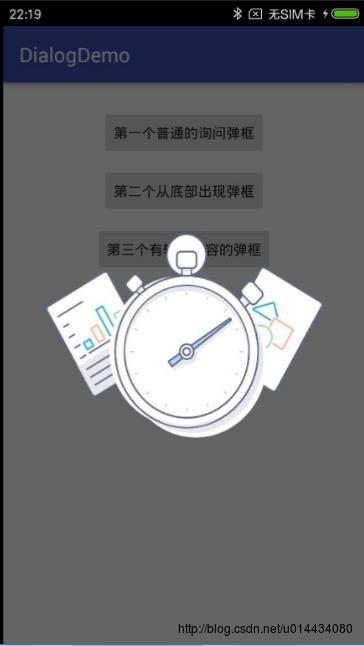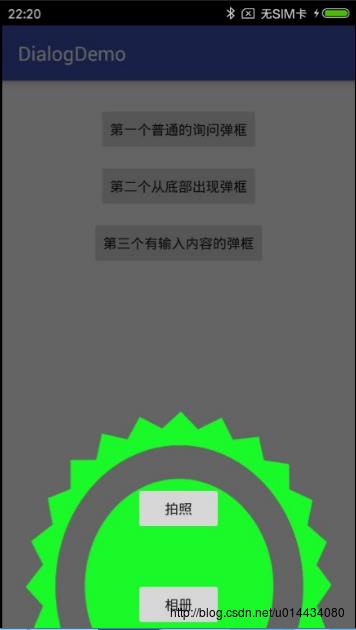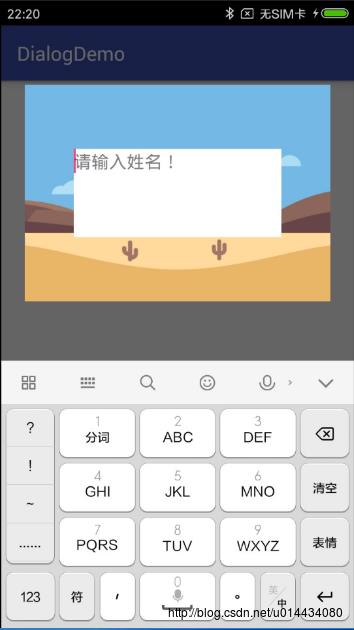一个简单的自定义Dialog
Posted 魏军强
tags:
篇首语:本文由小常识网(cha138.com)小编为大家整理,主要介绍了一个简单的自定义Dialog相关的知识,希望对你有一定的参考价值。
在平时的开发中,我们可能时常需要自定义Dialog,比如常见的需求,通知提示用户的dialog,第二种是从底部弹出的dialog,第三种是带输入框的dialog等。下面就是对一个自定义dialog的简单的封装。
直接看效果,不会作图,图都是网上找的。

1,看普通的提示框效果,我只是展示效果,界面并不是很详细

2,从底部弹出效果

3,带输入控件的弹出效果,自动启动输入法

下面时自定义的CustomDialog类:
/**
* Created by wjq on 2017/5/16.
*/
public class CustomDialog extends Dialog
private Context context;
private int height, width;
private boolean cancelTouchout;
private View view;
private int mLocation; //dialog从哪里弹出
private int dialogAnim; //dialog显示隐藏动画
private CustomDialog(Builder builder)
super(builder.context);
context = builder.context;
height = builder.height;
width = builder.width;
mLocation = builder.location;
cancelTouchout = builder.cancelTouchout;
view = builder.view;
private CustomDialog(Builder builder, int resStyle)
super(builder.context, resStyle);
context = builder.context;
height = builder.height;
width = builder.width;
mLocation = builder.location;
cancelTouchout = builder.cancelTouchout;
view = builder.view;
@Override
protected void onCreate(Bundle savedInstanceState)
super.onCreate(savedInstanceState);
setContentView(view);
setCanceledOnTouchOutside(cancelTouchout);
Window win = getWindow();
WindowManager.LayoutParams lp = win.getAttributes();
lp.gravity = mLocation;
lp.height = height;
lp.width = width;
win.setAttributes(lp);
public static final class Builder
private Context context;
private int height, width;
private boolean cancelTouchout;
private View view;
private int resStyle = -1; //dialog显示样式文件
private int location = Gravity.CENTER; //默认从中间弹出
private int animStyle = -1; //dialog进入及关闭时动画的样式文件
public Builder(Context context)
this.context = context;
public Builder view(int resView)
view = LayoutInflater.from(context).inflate(resView, null);
return this;
public Builder heightpx(int val)
height = val;
return this;
public Builder widthpx(int val)
width = val;
return this;
public Builder heightdp(int val)
height = DensityUtil.dip2px(context, val);
return this;
public Builder widthdp(int val)
width = DensityUtil.dip2px(context, val);
return this;
public Builder heightDimenRes(int dimenRes)
height = context.getResources().getDimensionPixelOffset(dimenRes);
return this;
public Builder widthDimenRes(int dimenRes)
width = context.getResources().getDimensionPixelOffset(dimenRes);
return this;
public Builder style(int resStyle)
this.resStyle = resStyle;
return this;
public Builder dialogStyle()
this.animStyle = resStyle;
return this;
public Builder location(int location)
this.location = location;
return this;
public Builder cancelTouchout(boolean val)
cancelTouchout = val;
return this;
public Builder addViewOnclick(int viewRes,View.OnClickListener listener)
view.findViewById(viewRes).setOnClickListener(listener);
return this;
public CustomDialog build()
if (resStyle != -1)
return new CustomDialog(this, resStyle);
else
return new CustomDialog(this);
当没有输入控件时Dialog样式
<style name="Dialog" parent="@android:style/Theme.Dialog">
<item name="android:windowBackground">@color/full_transparent</item>
<item name="android:windowFrame">@null</item>
<item name="android:windowNoTitle">true</item>
<item name="android:windowIsFloating">true</item>
<item name="android:windowIsTranslucent">false</item>
<item name="android:windowContentOverlay">@null</item>
<item name="android:backgroundDimEnabled">true</item>
</style>当有输入控件时Dialog样式
<style name="inputDialog" parent="@android:style/Theme.Dialog">
<item name="android:windowBackground">@color/full_transparent</item>
<item name="android:windowFrame">@null</item>
<item name="android:windowNoTitle">true</item>
<item name="android:windowIsFloating">true</item>
<item name="android:windowIsTranslucent">false</item>
<item name="android:windowContentOverlay">@null</item>
<item name="android:backgroundDimEnabled">true</item>
<!--下面这个是针对带输入内容的dialog时设置输入法自动弹出-->
<item name="android:windowSoftInputMode">adjustResize|stateAlwaysVisible</item>
</style>整个使用该自定义Dialog的类如下:
/***
* create by wjq
*/
public class MainActivity extends AppCompatActivity implements View.OnClickListener
Button btn_dialog_one;
Button btn_dialog_two;
Button btn_dialog_three;
CustomDialog dialog_one;
CustomDialog dialog_two;
CustomDialog dialog_three;
CustomDialog.Builder builder;
@Override
protected void onCreate(Bundle savedInstanceState)
super.onCreate(savedInstanceState);
setContentView(R.layout.activity_main);
btn_dialog_one = (Button) findViewById(R.id.btn_dialog_one);
btn_dialog_two = (Button) findViewById(R.id.btn_dialog_two);
btn_dialog_three = (Button) findViewById(R.id.btn_dialog_three);
btn_dialog_one.setOnClickListener(this);
btn_dialog_two.setOnClickListener(this);
btn_dialog_three.setOnClickListener(this);
builder = new CustomDialog.Builder(this);
@Override
public void onClick(View v)
switch (v.getId())
case R.id.btn_dialog_one:
showDialogOne();
break;
case R.id.btn_dialog_two:
showDialogtwo();
break;
case R.id.btn_dialog_three:
showDialogthree();
break;
private void showDialogthree()
dialog_three = builder.style(R.style.inputDialog)
.heightDimenRes(R.dimen.dialog_height)
.widthDimenRes(R.dimen.dialog_width)
.cancelTouchout(true)
.view(R.layout.dialog_three)
.build();
dialog_three.show();
private void showDialogOne()
dialog_one = builder.style(R.style.Dialog) //Dialog的样式
.heightDimenRes(R.dimen.dialog_height) //Dialog高
.widthDimenRes(R.dimen.dialog_width) //Dialog宽
.cancelTouchout(true) //点击Dialog外面,Dialog是否关闭
.view(R.layout.dialog_one) //Dialog布局文件
.build();
dialog_one.show();
private void showDialogtwo()
dialog_one = builder.style(R.style.Dialog)
.heightDimenRes(R.dimen.dialog_height)
.widthDimenRes(R.dimen.dialog_width)
.location(Gravity.BOTTOM)
.cancelTouchout(true)
.view(R.layout.dialog_two)
.build();
dialog_one.show();
上面就是对Dialog的简单封装。完整demo下载DialogDemo
以上是关于一个简单的自定义Dialog的主要内容,如果未能解决你的问题,请参考以下文章